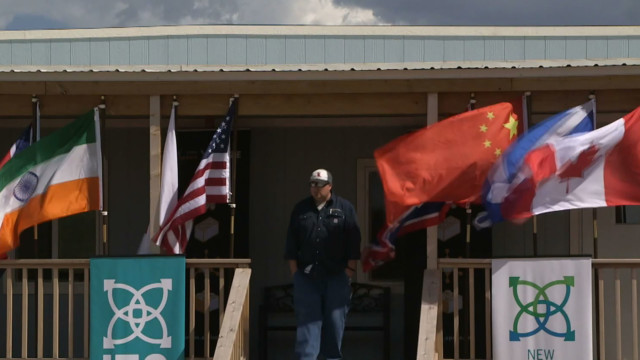The Wyoming Integrated Test Center is formally open for business.
Its the largest facility of its kind in North America. Researchers will come to the ITC to study the capture, sequestration and management of carbon emissions from a coal-fired power plant right next door.
CGTN’s Hendrik Sybrandy reports.
The Wyoming Integrated Test Center is formally open for business.
“It is the largest facility of its kind in North America, and as you can see behind me, this is not a lab,” Wyoming Governor Matt Mead told those assembled in the town of Gillette.
Researchers will come to the ITC to study the capture, sequestration and management of carbon emissions from a coal-fired power plant right next door. The goal is to apply next generation technology to a problem, excess CO2 in the atmosphere, that’s vexed scientists for years.
“CO2 is not a burden,” said Wayne Song, founder of C4X. “It’s a treasure, it’s an asset.”
C4X is one of the ITC’s first tenants. The Suzhou, China-based green carbon technology company is one of 10 finalists in the Carbon XPRIZE, a competition sponsored by two energy companies that challenges teams to convert carbon dioxide into valuable products.
“There’s too much of it in our atmosphere, in our environment,” Marcius Extavour, Carbon XPRIZE Director, referring to CO2 said. “We’ve got to find a way to reduce that and one way to do that is to actually recycle it into useful stuff.”
Half the participating teams in the competition will set up shop here. The other five are assigned to a natural gas plant in Canada.
“So this is one of the five test bays that will provide flue gas, electricity and processed water to the teams,” said Ray DeStefano, the ITC’s Operation Manager, pointing to one pipe running from the coal plant.
“That’s a safe spot where each team has basically got a pipe they can come up to, plug in, take some of that carbon dioxide coming off the plant and they’ve got to come up with a technology or process or something to transform that carbon into another useful material,” Extavour said.
During a previous round, Song’s team developed two carbon-based products at its pilot plant. One is packaging for environmentally-friendly coffee cups and interior parts of cars. The other is a textile made from CO2 that’s converted into ethylene glycol.
Teams in the final round must up their scale, converting two metric tons of CO2 a day. They’ll be judged on the engineering and marketability of their products and their ability to cut emissions. $15 million in prize money is at stake but Song said it’s about more than cash.
“50 years later, if we don’t solve this issue, I can imagine people really cannot breathe, cannot lead a normal life,” Extavour said. “The problem and the challenge is urgent and pressing,” he added.
He stressed that no single solution will crack the CO2 problem. “The goal here and the real prize is to stimulate new market activity and new innovation,” he said.
These new ways of converting carbon could conceivably ease global warming and be deployed at power plants and other industrial sites in the future.
 CGTN America
CGTN America

